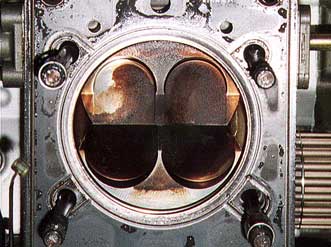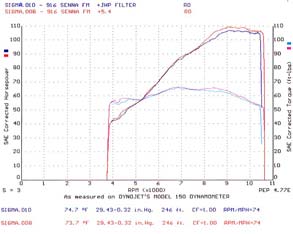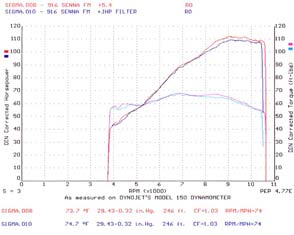|
Senna's were made in three series, just under a 1000 in all.
A charity fund-raising project for the Senna foundation they were standard 916 Biposto's with a higher spec of accessories. Carbon bits replaces plastic in a few highly visible areas like the chainguard and the mudguard and an aluminium subframe, it also had the most distinctive paintjob of the 916 series with dark grey metallic paint and red wheels.
Squish
The engine though was pure mid nineties 916 Biposto. These
engines, and all of the 916's, respond really well to careful set-up.
Ducati's quality control is getting better but there is still more throttle response to come from careful setting of the squish clearance (the distance between the piston crown at TDC and the head) and the cam timing.
Squish setting is not a change to the compression ratio, although it does increase slightly as a result, it is getting the distance between piston top and head surface down to a point where at
maximum revs the piston does not quite touch the head. Checked in static conditions the clearance closes up as revs rise and the rods stretch and the cases flex, it is important not to get
it too tight as a touch will destroy the engine in fairly short order.
Correctly set squish clearances ensure that all the mixture is jetted into the centre of the
combustion chamber with as much force as possible, so encouraging turbulence and 'tumble' in the charge, improving the totality of the burn and creating the best conditions for power (and as it
happens for emissions). The drawing above attempts to show the effect as the piston approaches TDC on the compression stroke.
 On engines where the clearance is too big there is carbon right to the
outside edge. This means mixture is sitting in this area and is not burning efficiently and is therefore not creating turbulence in the combustion chamber by being 'spat' into the chamber as the piston
approaches TDC. Correctly set the effect is analogous to slapping your foot hard into a puddle, the water flies everywhere, and the puddle nearly empties. Standard, it is similar to just plopping your foot in
to the water. If you look at engines where the squish is set properly you can see clean metal round the outside of the piston, as shown in the photo, proving that none of the mixture is sitting there being
partially burned. On engines where the clearance is too big there is carbon right to the
outside edge. This means mixture is sitting in this area and is not burning efficiently and is therefore not creating turbulence in the combustion chamber by being 'spat' into the chamber as the piston
approaches TDC. Correctly set the effect is analogous to slapping your foot hard into a puddle, the water flies everywhere, and the puddle nearly empties. Standard, it is similar to just plopping your foot in
to the water. If you look at engines where the squish is set properly you can see clean metal round the outside of the piston, as shown in the photo, proving that none of the mixture is sitting there being
partially burned.
The ignition timing will have been set on the assumption that the clearance will be right. Getting it
right therefore means that another main variable in engine performance can do its job properly. On a cautionary note it is possible to have too tight squish clearance, if you do major engine
damage will be certain to follow.
Full Monty
Enough of the tecchy stuff, back to Senna's. Steve Hannaford bought his bike to us for a Full Monty in April. The bike was completely standard apart from a 'over the intake stubs' undertank
airfilter, open pipes and the factory Senna '062' EPROM.
The Full Monty is a replacement for the first 'big service', it means we can set all the little
clearances in the engine to the ones Ducati intended the engine to have, but did not have the time or accuracy on the production line to achieve. It is a 'once and for all' reset of all the main engine
specs designed to get the engine to perform as well as it can.
We set all the valve clearances to the right numbers and we check the squish clearance is as
close as is practically possible. We believe that to get maximum efficiency from your engine the valves and their seats need to be cleaned up occasionally, on our race engines we do it every 200
miles, but that is how you try to win races against factory Honda's. On the street it means we preach the gospel of taking the heads off every 6000 miles to clean everything up and ensure
maximum compression. Sure it takes a little longer but the benefits of a full checkover are worth it.
Steve's 916 was no exception, we had to machine 0.3 mm off the bottom of the barrels to close
things up in the squish department. Once we had a good foundation the cam timing was set; this is just getting it to where it should be. Just to get it to 'standard' all the cams required moving, the
most exceptional was the rear cylinder exhaust, which required an 8 degree offset key (in Ducati parlance a '4 dot' key) to be accurate. In cam timing terms that is forever. Finally all the fuel
injection settings were set to zero plus or minus tolerances and the throttle bodies balanced. The result is an engine where each cylinder is working 'with' the other not fighting it.
The final course in this feast is a revised fuel injection EPROM. This allows the overall map to be
adjusted to allow you to take into account the little changes you see from machine to machine in fuel pressure. Pressure should be 3 bar, 44.1psi, but the fuel pressure regulator is a bit of
stamped out tin with a spring in it so figure on anywhere between 2.75 bar to 3.25 bar. As the whole mixture is based on a pulse of fuel at a certain pressure and of certain duration if either is
incorrect your fuel mixture will be wrong and your engine will not run as well as it can.
Ducati have always had the capability to have a different mixture in the rear cylinder but it is only
very recently that they have started to use it, FIM Ultimap EPROM's have very effective secondary maps for earlier Ducati's. Recently Ducati have started to map the rear cylinder from the factory
but the adjustments are very small and do not seem to take into account the additional turbulence the rear cylinder experiences when the bike is on the move. It is still possible to improve, in pure
performance terms, the standard or 'open pipe' EPROM with one correctly mapped for the specific engine.
SAE and DIN
 Back to Mr Hannafords Senna. Post Full Monty Steve reports that the engine idles
better, responds to throttle better, uses less fuel, goes faster and vibrates less. The first dyno chart shows the change with (008) and without (010) the foam undertank airfilter. The second shows the
same engine showing the same horsepower but calculated in DIN, if you need to boast about more horses get the chart in DIN! For those of you who care the new EEC standard is right between the two. Back to Mr Hannafords Senna. Post Full Monty Steve reports that the engine idles
better, responds to throttle better, uses less fuel, goes faster and vibrates less. The first dyno chart shows the change with (008) and without (010) the foam undertank airfilter. The second shows the
same engine showing the same horsepower but calculated in DIN, if you need to boast about more horses get the chart in DIN! For those of you who care the new EEC standard is right between the two.
This is a peak only 4 hp less than a 996 Biposto we recently built (see 996 bip tech), the only non-standard things in this engine are the EPROM and the barrel lengths. Everything else is still standard, just set-up correctly. Bear in mind that the
dyno we use has a reputation for being quite tough, this engine is putting out 6 bhp more throughout the range than the other (not prepared by us!) 916's that have used this dyno.
 Again we have to report that a foam undertank airfilter damages power. The standard filters may not be the most
effective filters but we see little evidence that engine wear is less with the big foam jobbies. The big foam filters also kill off the addictive intake roar, something I would not want to lose. To help ensure
any dirt that does get past the filters is caught we spray chainlube in the inlet tracts next to the airbox. Just like a K&N this grabs the dirt and encapsulates it, the
next bit of dirt just gets caught by the last bit, now covered by sticky chainlube. Again we have to report that a foam undertank airfilter damages power. The standard filters may not be the most
effective filters but we see little evidence that engine wear is less with the big foam jobbies. The big foam filters also kill off the addictive intake roar, something I would not want to lose. To help ensure
any dirt that does get past the filters is caught we spray chainlube in the inlet tracts next to the airbox. Just like a K&N this grabs the dirt and encapsulates it, the
next bit of dirt just gets caught by the last bit, now covered by sticky chainlube.
The engine has 45mm Termignonis, now with standard airfilters and has never in 12
,000 miles had a rocker failure. Steve uses the bike hard (2000 mile round trip to WDW2000; a three day 'perfection training
session at the Nurburgring, and a 1500 mile weekend blast to Switzerland, all within three months) but doesn't overrev it, wheelie it or give the clutch a hard time.
It is the best standard 916 I have seen, and it only took 30 man-hours of extra work, who needs
a 996?
Bargain.
Neil Spalding
Steve on his 916 Senna
|